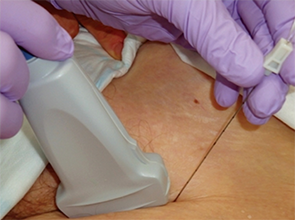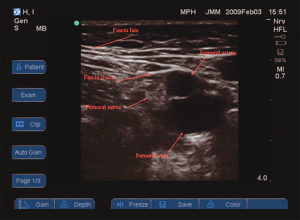As discussed in previous issues, the availability of options for severe pain control other than opioids has increased as our understanding of the mechanisms of pain neurobiology has grown. Another area that has come into the spotlight, since the advent of ultrasound, has been the use of regional anesthesia for pain control or for procedures.
Explore This Issue
ACEP Now: Vol 34 – No 04 – April 2015Initial use of ultrasound focused on its diagnostic utility with the development of the focused assessment with sonography for trauma, or FAST, exam—aortic aneurysm, intraperitoneal fluid, etc. That use has continued to expand, and ultrasound now can be used to diagnose congestive heart failure and even intravascular volume depletion by assessing the inferior vena cava.
Procedural uses for ultrasound have been, for the most part, limited to vascular access, peripheral or central, with only a few centers using ultrasound for regional anesthesia. This latter application should probably be the greatest use of ultrasound in our departments, not the least. Ultrasound-guided regional anesthesia (UGRA) is not only extremely safe, but it guarantees block success.
Benefits of UGRA
Initial studies looking at regional anesthesia discussed femoral nerve blocks for hip fractures. Ultrasound was not used. Although the studies described success in pain relief, closer review described the onset of pain relief from the blocks taking hours. In other words, many of the reported blocks were, in fact, not successful; onset of pain relief should take five to seven minutes. For many nerves, use of anatomical landmarks (blind technique) can result in unacceptably high failure rates and possible complications. Use of ultrasound will markedly change that and provide proper regional anesthesia in most hands. Unfortunately, UGRA is not considered a priority. Even in a center where femoral nerve blocks were done, time to UGRA for femur fractures averaged two hours prior to the initiation of a specific protocol that targeted a time of 15 minutes after arrival.1 In another study of patients with flail chest injuries requiring ventilatory support, where regional anesthesia (epidural) is supposed to be the standard of care, only 8 percent of patients received an epidural.2

Figure 1. In plane approach for ultrasound guided block of the femoral nerve.

(click for larger image)
Figure 2. Ultrasound view of the anatomy of the left femoral triangle.Source: Anaesthesia. 2010;65(Suppl 1):57-66. Reprinted with permission.
UGRA allows not only visualization of the needle to the nerve, it also allows visualization of the anesthetic flowing around the nerve. It is also provides proof that the needle did not touch other structures (such as the lung, artery, etc.). The combination of success with a very high safety record is something we should always seek. UGRA can be an excellent alternative to procedural sedation in patients at risk (eg, an ASA 3 patient who may not tolerate sedation or a patient with altered mental status). In such patients, UGRA such as supraclavicular brachial plexus blocks or sciatic nerve block in the popliteal fossa allows for painless reduction of distal dislocations or fractures without the risks of sedation or the need for complicated monitoring.
Pages: 1 2 3 | Single Page





No Responses to “Regional Anesthesia an Alternative to Opioids in the Emergency Department”